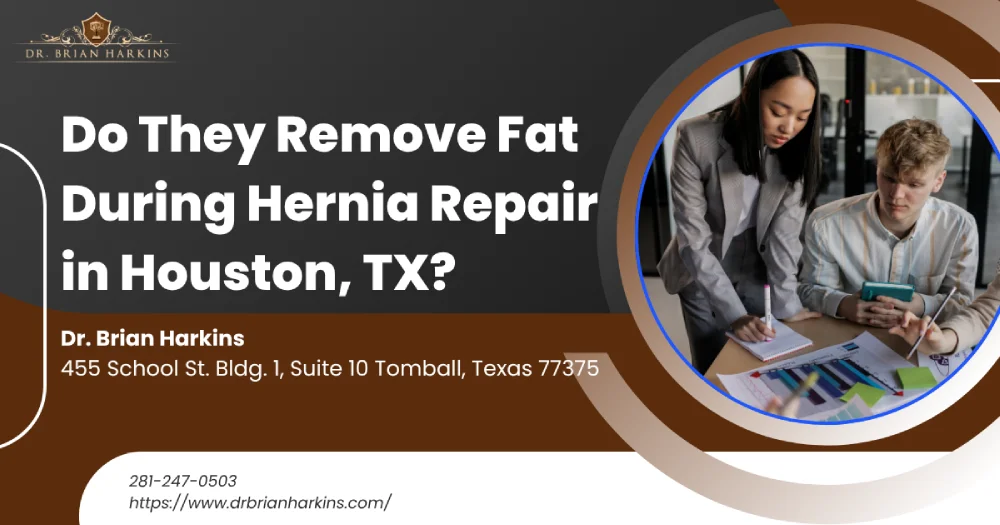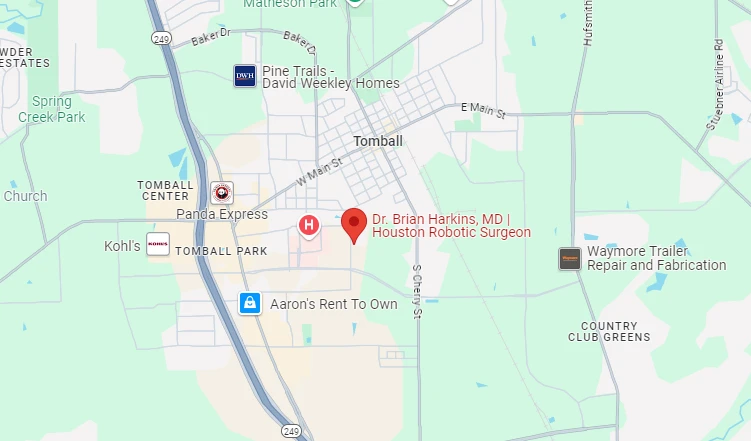
One of the first questions for a general surgeon is whether any belly-fat will be excised. So, do they remove fat during hernia repair in Houston, TX? The answer depends on the type of hernia and surgical approach. When Houstonians research hernia repair surgery, one of the first questions for a general surgeon is whether any belly-fat will be excised. In short, fat is sometimes—though not always—removed during the procedure. If only fat protrudes through the weakened area of the abdominal wall, a surgeon may trim or gently push it back into the abdominal cavity. Below, you’ll find a detailed, TX-specific guide that blends expert surgical care with practical advice on recovery, costs, and how to schedule a consultation in our offices in Houston and Katy.
A hernia is a bulge created when tissue such as omentum or bowel squeezes through a weakened area of muscle and fascia. When pressure rises—from heavy lifting, chronic cough, or pregnancy—fat usually protrudes first. If left untreated, the defect can widen and bowel may strangulate, requiring emergency care in TX.
During hernia repair in Houston, surgeons follow a simple algorithm: if the fat is viable and easily reduced, they push it back. If it is necrotic, strangulated, or excessively bulky, they remove excess fat so the mesh patch can lie flat, alleviating tension and reducing recurrence.
| Hernia Contents | Condition | Standard TX Action |
|---|---|---|
| Small pad of healthy fat | Pink, well-perfused | Reduce into the abdomen |
| Large lobule of fat | Creates tension | Partial resection, remainder reduced |
| Strangulated fat | Dark, no pulse | Complete excision, lavage, suture repair |
| Intestine + omentum | Both viable | Reduce both; rarely resect fat |
Benefits
Risks
The approach you and your hernia specialist choose—open, laparoscopic hernia repair, or robotic—affects how easily fat can be visualized, reduced, or removed. Houston’s Texas Medical Center offers all three.
Before signing a consent form, schedule a consultation and ask direct questions about fat management, mesh choice, and post-operative expectations.
Most patients can’t tell whether fat was resected once incisions heal. Recovery timelines, post-operative pain, and lifting limits are nearly identical to those whose fat was simply reduced.
Houston’s medical landscape offers community hospitals and academic centers. Choose a surgeon performing high-volume inguinal hernia repair and advanced abdominal wall reconstruction. Verify accreditation, ask for recurrence statistics, and make sure imaging, such as office ultrasound, is available during your initial consultation.
Surgery fixes the defect, but lifestyle determines whether pressure—and fat—returns. Adopt Houston-friendly habits such as farmers-market shopping, park workouts, and avoiding heavy straining at oil-field or warehouse jobs.
During hernia repair surgery in Houston, surgeons weigh the health, size, and impact of protruding fat before choosing excision or reduction. Either path delivers similar healing times, especially when patients prepare their bodies, pick an experienced provider, and commit to healthy post-operative habits. Ready for the next step? Schedule a consultation with Dr. Brian Harkins to determine the best approach for your specific hernia.
Not always. During hernia repair, Houston surgeons often push healthy fat back into the abdomen unless it’s bulky, damaged, or causes tension. If the fat is strangulated or interferes with mesh placement, your general surgeon may remove it for better healing and to reduce hernia recurrence. Whether it's an umbilical, inguinal, or ventral hernia, the decision depends on the defect size, fat condition, and the surgical technique used.
Laparoscopic hernia repair requires smaller incisions, which translate to fewer wound-related infections compared with open surgery. The internal view also limits skin exposure to bacteria. However, proper sterile technique, antibiotic timing, and patient factors like diabetes still play big roles in overall infection rates.
Most unilateral inguinal hernia repair procedures—in both open and minimally invasive formats—take 45–75 minutes. Anesthesia time includes induction, positioning, and safe wake-up. Bilateral or recurrent repairs may add 20–30 minutes, especially when mesh removal or scar tissue dissection is necessary.
When a hernia occurs and remains untreated, the opening in the abdominal wall often widens, allowing intestine to protrude or strangulate. Symptoms may escalate from a painless bulge to severe pain, vomiting, or bowel obstruction—turning an elective procedure into an emergency surgery performed under general anesthesia.
Drains are uncommon in routine inguinal or umbilical repairs but may be placed after large ventral or incisional cases when substantial fat is excised. A closed-suction drain prevents seroma formation by removing fluid from dead space. Most drains are removed within seven days.
For very small defects—particularly pediatric umbilical hernias—surgeons can sometimes use primary suture closure without a mesh patch. However, adults have higher recurrence rates without mesh, even if only fat was protruding. Your surgeon will weigh defect size, tissue quality, and activity level before deciding.
Athletes often enjoy a faster recovery with laparoscopic surgical techniques. Light cardio is typically allowed at two weeks, while contact sports and heavy lifting resume around six to eight weeks. Clearance depends on stable mesh incorporation, absence of pain, and the athlete’s commitment to gradual core conditioning.
Higher BMI correlates with thicker omentum and larger pre-peritoneal fat pads. Surgeons may choose to remove excess fat to reduce tension on the abdominal wall muscles and improve mesh placement. Obesity also heightens infection risk, making meticulous fat management—and weight loss before surgery—crucial.
Recurrence is multifactorial, but residual bulky fat can create tension or compromise mesh position, especially in the groin. If a groin hernia reappears, imaging will assess whether untreated fat, mesh failure, or new tissue weakness is responsible. Revision surgery may involve fat excision and stronger mesh fixation.
Robotic platforms provide wristed instruments, 3-D optics, and enhanced ergonomics, enabling finer dissection and layered closure. Surgeons can trim fat without enlarging ports and perform complex reconstructive suturing for large ventral defects. While facility costs rise, many patients experience less pain and lower hernia recurrence with robotic precision.


Dr. Brian Harkins is a renowned surgeon specializing in advanced, minimally invasive, and robotic surgical techniques. With a dedication to innovation and personalized patient care, he has transformed countless lives by delivering exceptional outcomes.

I want a website like this, where do i start?